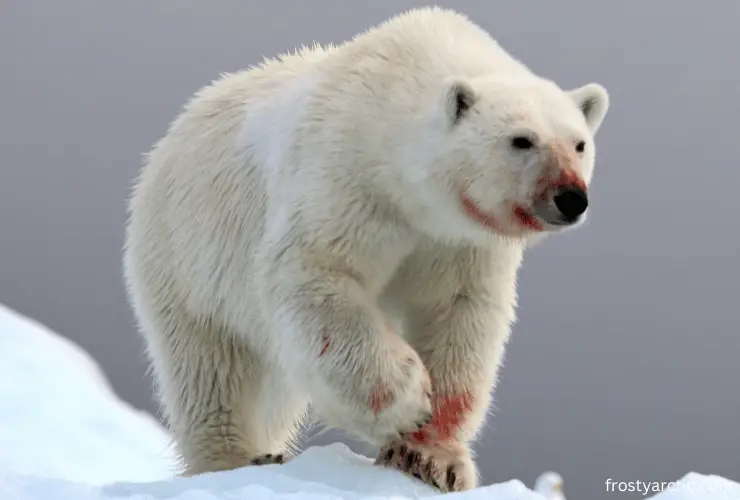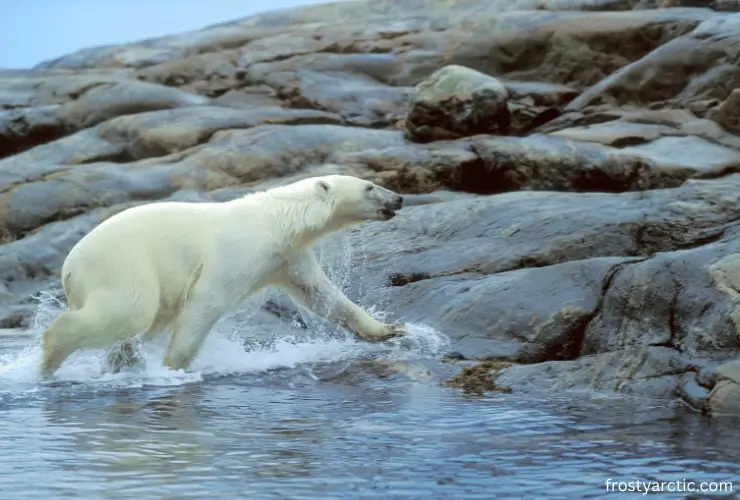Polar bears can run at a top speed of 40 km/h (25 mph) on land. Their casual speed is less than 30 km/h (18.6 mph per hour). They can run for only short distances. The speed of polar bears in water is slower. This is up to 6 to 10 km/h (3.73 to 6 mph).
Do you know what the speed of the fastest polar bear ever living on Earth is? Why are polar bears lazy and they do not run unnecessarily? We know all these queries are whirling in your minds. Let’s just check out all facts related to the topic: how fast can a polar bear run? This article is going to be very interesting and fun!
How Fast Can a Polar Bear Run on The Ground?
Most people think that polar bears have bulky bodies, and they can’t run fast. However, this is just a misconception. They are super-fast. Do you know that the speed of a running polar bear is close to the running speed of the fastest human, Usain Bolt?
Usain’s fastest speed ever recorded was 44 km/h. Let’s compare this speed with the speed of a running polar bear. According to hundreds of studies, polar bears can run at a speed of 40 km/h. Not bad! Now, you can imagine how fast a polar bear can run even with heavy bodies.
This was all about the speed of a polar bear when it is running. Otherwise, their moving speed is so slow. They move at a roundabout 5.5 km/h (3.4 mph). They do not run unnecessarily because their bodies heat up. So, they swim in the water to cool down.
Can Polar Bears Run on Their Hind Legs?
Yes. According to a study by the SeaWorld organization, polar bears run on their hind legs. But the issue is they cannot run or move for a longer period of time. In short words, they briefly run and move on hind legs, just like other bear species.
This behavior is shown when they are trying to see things to get a better view. They run and walk on all fours. This type of physical adaptation is energy efficient and stable for them, instead of walking on heels.
Polar Bear Running Speed Vs Other Bear’s Running Speed

According to various studies, all species of bears are quick runners. However, there are some bears that are not as fast as others. That’s why we are considering the rates at which each breed runs.
Here is a quick comparison table that shows the comparison of the polar bears’ running speed with other bear species’ running speeds. Let’s jump into it:
| Name of the Bear | Running Speed | Description/Explanation |
| Polar bears | 25 miles per hour | Polar bears are agile and majestic predators of the Arctic. They are not marathon runners, but they can run so fast at short distances. Let’s see who can run faster than polar bears. |
| Grizzly bears | 35 miles per hour | Grizzly bears, also known as brown bears, have the highest running speed. The credit goes to their powerful forelimbs that help them to sprint. The fastest running speed shows they can dig at a speed rate that’s just remarkable. |
| American black bear | 30 miles per hour | The speed of an American black bear is closest to the speed of grizzly bears but still fails from a few points. The speed of these blackish bears is double the running speed of an average man. Recently, 13 black bear attacks on humans were recorded in North America. All because of their running speed when they are chasing prey. |
| Spectacled Bears | 30 miles per hour. | Despite their short sizes and less weight, spectacled bears run faster than polar bears. These are close runner-ups of Grizzly bears and American black bears. Their sharp claws help them to dig, climb, and run exceptionally. |
| Sun Bears | 30 miles per hour | These are the smallest bear species of the bunch of others. Their size characteristic is beneficial for them. They can run at the fastest speed of 30 miles per hour, relatively faster than polar bears. |
| Asiatic black bear | 25 miles per hour | Thank God! Someone is matching the speed of polar bears. Asiatic black bears have relatively smaller physiques than polar bears. But these bears run at the same speed as polar bears. Sadly, these are now enlisted as endangered species of bears. |
| Sloth Bear | 20 miles per hour | These are sloths – lazy creatures. That’s why they do not have the capability of running fastly. They run slower than polar bears. |
| Panda Bear | 20 miles per hour | If the award for the slowest and lazy bears is given, then pandas will receive it. They are the slowest bear species. Still, they can run at a speed of 20 miles per hour. It is said that they are herbivores, not hunters, that’s why they are super slow. |
| Kodiak bears | 30 miles per hour | Kodiak bears run faster than polar bears. Not just this, these bears are the second heaviest and most bulky bear species after polar bears. Thanks to their strong muscles that help them to run with astonishing speed. |
How Fast Can a Polar Bear Run Underwater?
According to the report of the World Wildlife Fund-UK organization, polar bears can run at a speed of 10 km/h underwater. In simple terms, their swimming speed is 10 km/h, which equals 6.2 miles per hour. That’s pretty cool, not bad!
Fun Fact Time
Once a polar bear creates a record-breaking journey. It swam for more than 9 days. The bear covers 687 kilometers of distance. Quite surprising. Isn’t it?
In another study, polar bears are mammals and not fish. Still, they swim significantly faster than humans, but obviously not faster than fish. Their speed matches with one of the fastest swimmers, Michael Phelps. Furthermore, they love to swim. They have the ability to swim for hours over long distances.
According to one of our Quora Digest colleagues, polar bears’ stamina is so high. One of the record-cracking polar bears covers 440 miles while swimming at a rapid pace. It started the journey from the North Pole of Alaska and ended at the nearest sea.
Important Note
The swimming speed of polar bears is not well-documented as their running speed on land. The above-mentioned swimming speed is an estimated figure. Polar bears use their strong front limbs to paddle through the water. Plus, they use their hind legs to steer in the water.
How Long Can a Polar Bear Run?
According to the report of Polar Bear Facts, polar bears can run short distances. The distance they can run in a single burst is not yet studied. However, it is generally considered to be relatively short. They can run for a few hundred yards (or meters) at most.
The reason behind running for short distances is simple. Their muscular bodies are simply not designed for long-distance running. They are more specialized in activities like swimming and walking.
According to one of the studies, polar bears can run for 2 kilometers without taking a break. And younger and leaner polar bears are recognized as the best runners. Oldies and cubs are not as fast as the younger ones. Here is a complete video documentary about how fast a polar bear runs.
How Do Polar Bears Move on Ice?

Ice has low friction. That’s why it’s slippery for ordinary creatures to move and walk elegantly on ice. However, it’s not a big deal for polar bears. They move very well on ice by distributing their weight across difficult surfaces. Also, they spend most of their lives in the water in the slippery and icy Arctic.
Credit goes to their well-balanced gait while walking on ice. The gait of polar bears is unique to other bears. Moreover, their paws are rough from underneath. Their claws are short and sharp nails provide them maximum friction to walk on ice. They are artistic in walking with a sway while moving one leg at a time!
How Far Do Polar Bears Travel?
Polar bears mostly travel within their home range. They regularly travel in their home ranges to search for their mates and food. Probably, you are thinking that their home ranges are a few kilometers or smaller distances. It’s not like that.
Usually, terrestrial mammals have short-distance home ranges. But, polar bears have much larger home ranges. According to a reliable estimate on ResearchGate, the normal home range of an Arctic bear is around 125,100 km².
In the study in this ResearchGate journal, the average walk of a polar bear is also estimated accurately. They can roam 30 kilometers (19 miles) in their territories/home ranges restlessly in a single typical day. It doesn’t mean they will stop walking after a day or two.
GPS Tracker Experiment
In fact, polar bears try to continue their approx. 30 kilometers walking pattern every day. An experiment also revealed a shocking fact about how far polar bears travel. For this, GPS trackers were used to track their everyday traveling distance.
One of the polar bears was tracked traveling 80 kilometers (approximately 50 miles) within one day and night. Another was tracked walking 1,119 kilometers (approximately 695 miles) within one year. These facts really make us stunned and perplexed.
Can A Human Outrun a Polar Bear?
No, a human cannot outrun a polar bear. The average running speed cannot exceed the running speed of a polar bear, which is 40 kilometers per hour in short bursts. The speed of polar bears matches the speed of a racehorse. On the other hand, humans cannot sprint at this speed, they can run at an average speed of 24 kilometers per hour.
It means only Usain Bolt can outrun a polar bear in any scenario. So, attempting to outrun a polar bear is futile and dangerous at all costs. In conclusion, we can quote: “Four Legs Good, Two Legs Bad“. It means a 4-legged creature, a polar bear, wins over bipedal humans. ~ Source
What Should You Do If You Encounter a Wild Polar Bear?

We have learned much about the speed of polar bears. Now, let’s see what you should do in case of a polar bear encounter. First of all, avoid those places and situations where there are chances of meeting a polar bear. Still, somehow you get in trouble, try to follow the following guidelines if you encounter a wild polar bear:
- Stay Calm: Sudden voices and panic behavior can startle the polar bear.
- Give Space: Try to move away slowly and quietly from the polar bear. Keep a respectful distance.
- Avoid Eye Contact: All bear species, including polar bears, take eye contact as a threat or challenge for them. So, avoid eye contact.
- Do Not Run: Running can trigger the predatory instincts of polar bears. They are excellent sprinters. If you think you can outrun them, you cannot. So, don’t try to run.
- Use Bear Spray: Have a bear spray with your tour in polar bear habitat or where there are chances to encounter these predators. If you see them, slowly and carefully remove your spray from its holster. Use it as a deterrent if a polar bear tries to come closer to you.
- Stay Safe: If you have a car or any vehicle, stay inside there. Do not try to come out. Polar Bears are not chill buddies.
Last, but not least, you can call the nearest help available. Get assistance as soon as possible to keep yourself safe and sound!
How Do Polar Bears Move – The Biomechanics of Quadrupedalism
According to the advanced publication of a ResearchGate journal article, bears are the one and only group of quadrupedal mammals. It shows they follow quadrupedal locomotion which means they move on all four limbs. Their biomechanics involves synchronized movement of the front and hind legs.
Limb protraction and retraction help in propulsion, with a push-off from the hind limbs. Moreover, polar bears use the digitigrade posture where they walk on their toes to distribute weight effectively. This type of special quadrupedal adaptation underpins the survival of polar bears in diverse terrains of the Arctic.
Who Is Faster, A Polar Bear or A Tiger?
Tigers are faster than polar bears. We came to this conclusion because the speed of tigers is roughly twice the speed of white bears.
Tigers can run at a speed of 40-50 mph, while polar bears run at a speed of only 25 mph. Hence, the answer is as clear as crystal.
Is a Dog Faster Than a Polar Bear?

Yes, a dog is faster than a polar bear. However, it depends on the dog breed. Not all dog breeds can run faster than a polar bear. As we know, dogs are bred for various purposes, including speed, agility, and endurance. Also, the speed of a dog varies based on the breed. Let’s take an example.
Greyhound is a dog breed that can run at a speed of 45 to 50 miles per hour, which is faster than the speed of a polar bear. But the average dog speed is around 31 miles per hour, which is less than the speed of polar bears. It shows this breed of dog is faster than a polar bear. There are many breeds of dogs that are not quick footers.
Did you know?
Only 3 to 5 percent of breeds of dogs are faster than polar bears. Some of the dog breeds that can outrun a polar bear include:
- Weimaraner – 35 mph
- Dalmatian – 37 mph
- Jack Russell terrier – 38 mph
- Saluki – 45 mph
- Greyhound – 45 mph
Many other dog breeds are faster than polar bears.
Frequently Asked Questions
What Is the Fastest Bear in The World?
According to a study by the National Wildlife Federation, Grizzly bears are the fastest bears in the world. These are the subspecies of the brown bears. These bears are fast and furious and can run at a top speed of 35 to 40 mph. Only Usain Bolt can outrun a Grizzly bear! ~ Source
What Is the Fastest Animal in The World?
Cheetah is the fastest animal in the world. It can accelerate from 0 to 60 miles per hour (97 kilometers per hour). Cheetahs are built for speed. They have outstanding adaptations like a lightweight body, long legs, and specialized muscles. These adaptations allow them to achieve these remarkable velocities.
Is A Polar Bear Faster Than a Gorilla?
Yes, a polar bear is faster than a gorilla. Gorillas can run at a speed of 6 miles per hour. This estimate shows that gorillas can travel at a slow trot. Thus, polar bears will always win the race if the other participant is a gorilla.
Is A Polar Bear Faster Than a Jaguar?
No, the polar bear is not faster than a jaguar. Jaguar is 3 to 4 times smaller than polar bears, but these animals are generally faster than polar bears. You know jaguars can cover a distance of 40 to 50 miles per hour. This estimate shows jaguars have a speed advantage over polar bears’ size.
Why Do Polar Bears Run at Such a High Speed?
Polar bears mostly try to save their energy and do not run without any reason. Here are a few reasons why they run at a high speed:
- To catch prey.
- To protect their cubs.
- For survival from predators, especially humans, and orcas.
- To find suitable new habitats from their current home.
- In search of food.
- Behind potential mates.
- To avoid confrontations from other bears.
Polar bears also engage in playful behaviors like rolling around, wrestling, sliding on ice, and so on. So, there are chances that they may also run out of fun.
How Fast Can a Polar Bear Run A 40-Yard Dash?
Let’s understand it with an example of a fast high school halfback who runs at a 40-yard dash. He can complete the distance within 4.5 minutes. On the other hand, polar bears can dash at a rate of 44 feet every second.
We took this estimate from the polar bear’s running speed. Otherwise, it’s important to note that the 40-yard dash is typically used to measure the speed of human athletes. It might not provide a direct comparison if we refer to it for polar bear speed.
Is A Polar Bear Faster Than a Hippo?
No, polar bears are not faster than hippos. Hippos can run at the fastest speed of 30 mph, which is relatively faster than a polar bear.
Conclusion
So, have you ever noticed why polar bears are so fast at running? They need to eat meat. So, they are fast and intelligent enough to catch the other fast-running animals. They are amazing creatures and stand out from the crowd due to their fast speed. We know they are not the fastest animals in the world, but they are faster than hundreds of other animals. They are not built for speedy predators; their impressive personalities have other factors to count that make them unique.
Do you know what are those factors that influence them as one of the biggest predators? Share your views in the comments section. We would love to hear from our readers!



2 thoughts on “How Fast Can a Polar Bear Run? [Compared with Other Bears]”